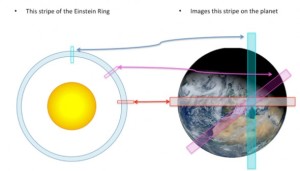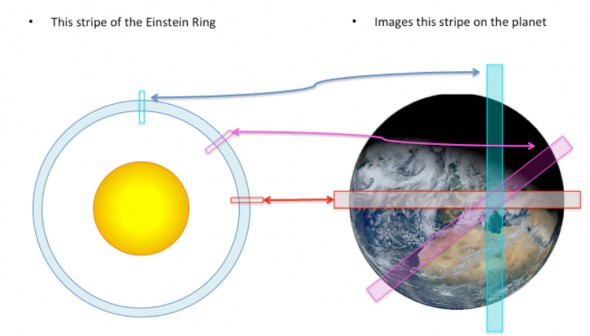
A Space Mission to the Gravitational Focus of the Sun
The search for an Earth-like planet orbiting another star is one of astronomy’s greatest challenges. It’s a task that appears close to fruition. Since astronomers spotted the first exoplanet in 1988, they have found more than 2,000 others.
Most of these planets are huge, because bigger objects are easier to spot. But as sensing techniques and technologies improve, astronomers are finding planets that match Earth’s vital statistics ever more closely.
They have even begun to use a ranking system called the Earth Similarity Index to quantify how similar an exoplanet is to the mother planet. The exoplanet that currently ranks most highly is Kepler-438b, which orbits in the habitable zone of a red dwarf in the constellation of Lyra some 470 light years from here.
Kepler-438b has an Earth Similarity Index of 0.88. By comparison, Mars has an ESI of 0.797, so it’s more Earth-like than our nearest neighbor. That’s exciting but it is inevitable that astronomers will find planets with even higher indices in the near future.
And that raises an interesting question: how much can we ever know about these planets, given their size and distance from us? After all, the limited size of orbiting telescopes places severe restrictions on how much light and information we can gather from an Earth analogue.

But there is another option—the gravitational field of the sun can focus light. Place a telescope at the focal point of this giant lens and it should become possible to study a distant object in unprecedented detail. But how good would such a lens be; what would it reveal that we couldn’t see with our own telescopes?
Today we get an answer to these questions thanks to the work of Geoffrey Landis at NASA’s John Glenn Research Center in Cleveland. Landis has analyzed the resolving power of the solar lens and worked out just how good it could be.
The basic physics is straightforward and has been worked out in some detail by astronomers in the past. General relativity predicts that light must bend around any massive object. The effect is tiny, however, and only observable with objects of truly enormous mass.
Despite its size, the sun only bends light by a tiny amount. Consequently, the focal point of our solar lens is at least 550 astronomical units away. That’s beyond the orbit of Pluto and the Kuiper Belt, which extends a mere 50 AU.
Nevertheless, it is a tempting stepping stone given that there is little of interest between the Kuiper Belt and the next nearest star, Alpha Centauri, which is 280,000 AU distant. “There is thus a powerful incentive to find some plausible objective in visiting the gravitational focus, as a potential intermediate step toward a future interstellar mission,” says Landis.
But there are significant challenges in using the sun as a gravitational lens. The first is related to pointing and focal length. The idea is to place a spacecraft on the opposite side of the sun from the exoplanet, but it cannot sit exactly at the focal point where the light from the exoplanet converges.
That’s because any image would be drowned out by light from the sun, which would still be the brightest object in the sky. Instead, the spacecraft would sit beyond the focal point where the light from the exoplanet would form into an Einstein ring around the sun. It is this ring that the mission would have to sample.
But it is not just the sun that can drown out the image. The solar corona, the aura of plasma that surrounds the sun, is also a problem, and this extends much further. To ensure that the Einstein ring is larger than the corona and not obscured by it, the mission would have to sit even further, at a distance of more than 2,000 AU, says Landis. That’s much further than the 550 AU that previous analyses have suggested.
It is a simple matter to show that this mission could only have a single objective. To point at a different object just 1 degree away, the telescope would have to move at least 10 AU around the sun, equivalent to the distance from Earth to Saturn. “A significant difference of the solar gravitational lens from a conventional telescope is that the gravitational lens telescope is not in any practical sense pointable,” says Landis.
But given a specific target, the focal power of the sun produces a hugely magnified view. To demonstrate its potential, Landis uses the hypothetical example of an exoplanet orbiting a star some 35 light years away. If this planet were the same size as the Earth, the image at the focal plane of the sun would be 12.5 kilometers across.
So the mission could only ever see a small fraction of the planet’s surface. Indeed, a telescope with a one-metre detector would image a one kilometer square area on the surface of the planet—that’s smaller than New York’s Central Park.
Pointing a telescope at an area so small and distant is tricky. There can be no “finder scope” on such a telescope because the target would be invisible except when using the gravity lens. So the exoplanet’s position will have to be known with high precision.
Even then, pointing it will not be trivial. “Finding a planet of diameter ~10^4 km at a distance of 10^14 km requires a pointing knowledge and pointing accuracy of 0.1 nanoradians,” says Landis. State-of-the-art pointing accuracy is today about 10 nanoradians.
But that’s just the start. The exoplanet will be moving as it orbits its star. Landis analyses what would happen if the exoplanet has the same orbital velocity as the Earth, 30 km/sec. In that case, a one-kilometer section of the planet will traverse a one-meter detector in just 33 milliseconds and the entire planet will slip past in 42 seconds.
Preventing blur by moving the telescope to track the image will be hard. Landis says that the spacecraft will need to change its velocity by 30 meters per second to keep up and that over the course of a year it would follow an ellipse with a semi major axis of about 150,000 kilometers. It’s not clear what kind of propulsion system would be capable of this.
The alternative, of course, is to use image processing techniques to remove the blur, which is increasingly doable with today’s technology.
Another major problem is filtering out the light from the sun, not to mention the exoplanet’s parent star, which will be orders of magnitude brighter than the target. The telescope will also have to minimize interference from other sources such as zodiacal light. Much effort has been out into this for the current generation of planet hunting telescopes. Nevertheless, Landis says, this is not a trivial problem.
Given all these problems, how much better the image from a gravitational lens be compared to an unlensed image? Landis’s estimate is that the lens increases the intensity of light from the exoplanet by a factor of 100,000.
That’s a significant advantage. But it can only be realized if the exoplanet light can be well separated from the light from other sources such as the sun, the corona, the parent star, and so on. And this is a big unknown.
The utility of the mission depends on this. “Given all the difficulties, is it worth traveling out to beyond 600 AU to merely gain a factor of 100,000? Is this enough?” asks Landis.
That’s a question that astronomers, funding agencies, and the public at large will have to consider in some detail. Landis makes no suggestion that such a mission should be undertaken now or is even possible or affordable. But his analysis has certainly raised the stakes.
Going further, it seems hard to understate the significance of finding an Earth analogue that has the potential to support life. The idea of mapping areas on this planet that are just one kilometer in size will be powerful motivation.
On Earth, this kind of image would reveal islands, rivers, parks, Great Walls, freeways, cities, and so on. Perhaps a spacecraft sitting at the gravitational focus of a distant star is revealing these things right now to a spellbound alien population. Just imagine.
Ref: arxiv.org/abs/1604.06351: Mission to the Gravitational Focus of the Sun: A Critical Analysis

Leave a Reply